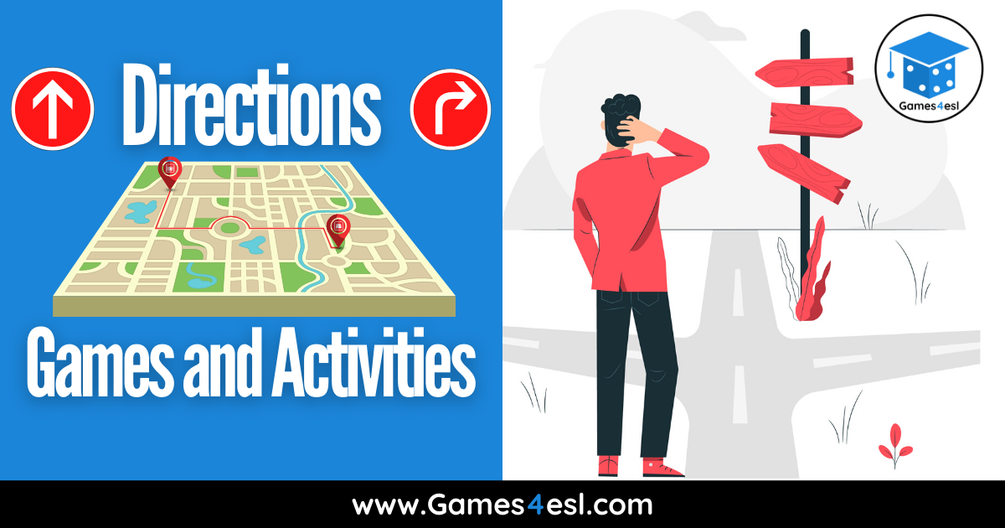

Check out these 6 fun directions games and activities about giving directions in English. These games are great for teaching directions to ESL students and other beginner English language learners, and best of all they are completely free and require little to no preparation. Check out the games below and check the bottom of the page for related resources for teaching directions in English.
Also, check out the bottom of this page for related resources.
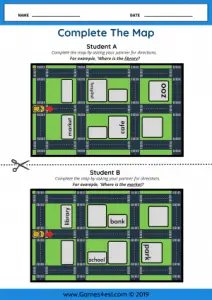
Next on our list of games to teach directions is an ‘Info gap’ style activity worksheet. Info gap activities are those in which each student only has part of the information, and to find out the rest of the information they must talk with their classmates. To play this directions information gap activity, print out this worksheet (or make your own) and then cut it in half along the dotted line. Give one half to student A and one half to Student B.
Then, without showing their map to their partner, they must ask for directions to find out where the places are on the map. For example, ‘Where is the library?‘ – ‘ Go straight 1 block and turn left. It’s on the left.‘ Once students have completed the map, they can compare their map with their partner’s. Both maps should be the same if they followed the directions correctly. For more worksheets to teach directions, and other ESL topics, check out our worksheets page.
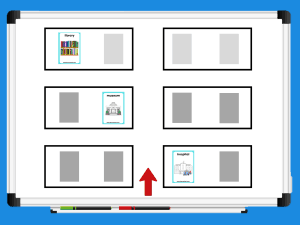
This next ESL activity to teach directions is a simple memory game. For this game, you’ll need a set of buildings / places flashcards. First draw a simple map on the board. This can be as simple as drawing squares, like in the picture above, to represent the blocks on a map.
Next, attach the flashcards to the board with the back of the flashcard facing the students (i.e. so students can’t see the pictures of the flashcard). Then, divide the class into two teams. Now the game can begin.
Ask team A ‘Where is the (police station)?‘. Then team A must guess where it is and give directions in English to where they think it is on the map. For example, ‘Go straight two blocks and turn right. It’s on the left.‘ Follow the students’ directions on the map and then turn over the flashcard. If they guessed correctly, they get a point for their team. If they guessed wrong, then turn over the flashcard to hide the picture again.
Next, ask team B another question such as ‘Where is the (market)?‘. Team B should then guess by giving directions to where they think it is on the map. After a few turns students will start to remember where they saw the places on the map. Once all the places on the map have been found and all the flashcards have been turned over, the team with the most points is the winner. This directions game is incredibly fun and very easy to set up, and is a fantastic speaking activity to review directions in English.
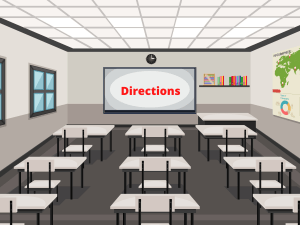
This next activity is a fun no-prep classroom game to practice directions. Before playing this activity, you may want to practice some directions vocabulary and sentences with students. Here are some directions flashcards you can use to drill the target language.
To play this game, first make sure the desks in your class are arranged in a grid, like in the picture above. Tell students that the desks are ‘blocks’ and the space between the desks is the road. Next choose one student to be ‘it’. Tell this student that someone has stolen their pencil case and so they must go to police station to report it.
Then, ask this student to close their eyes / look away. Next, point to another student in the class.This student is the ‘Police / Police Station’. Make sure all students can see where the ‘Police Station’ is. Next, tell the student at the front to open their eyes and ask ‘Where is the police station?’. The other students in the class should then direct her to the police station using directions in English. Kids really love this directions activity. To make it even more fun, place a blindfold on the student at the front and have them follow the directions while blindfolded.
This activity is another no-prep classroom game that you can use to teach directions to kids. It is based on the children’s game ‘Simon Says’. If you’re not familiar with Simon Says, it is a game in which the teacher would give instructions and the students should follow. But, they should only follow the instructions if the teacher first says ‘Simon Says…’ (E.g Simon says touch your head.)
This game can be used very effectively to teach directions vocabulary to kids. To play, first teach students the key words and actions. For example, teach students the word ‘walk’ and mime walking on the spot. Then teach them ‘turn right’ and mime turning right. Do the same with other key phrases such as turn left, go straight, stop, keep walking, etc.
Once students have practiced enough, start the game. Tell students to follow your directions, only if you say ‘Simon says…’ first (or ‘Teacher says…’ / ‘Tom says….’, etc.). From time to time give students directions without saying ‘Simon says…’ first, and if any student still does the action, then that student is out, and must sit down. This game is incredibly fun and encourages kids to listen carefully. Once students have practiced a little, try giving the directions really fast to make it even more fun.
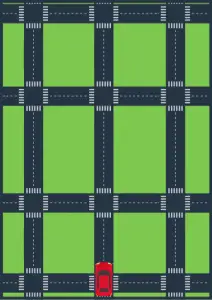
This last directions activity is based on the classroom activity ‘Walking Dictation’. To play, divide the class into small groups of 3/4. Give each group a simple map and one pen / pencil. You can use this simple map, or create your own. Then ask one member from each group to come to the teacher. Show these students the location of a building (i.e. school / hospital, etc) on the map.
Then, when the teacher says ‘Go!’, these students must go back to their team. Their team mates must ask ‘Where is the (school)?’ and the student must direct them to where the school is on the map using directions in English. Then, they should write ‘school’ in the correct location on the map. The first team to accurately write the location of the school on the map is the winner and gets one point for their team. Then, call the next student from each group up to the front and repeat.
Thanks for reading. I hope you found some useful materials and activity ideas for teaching directions in English. Before you go, check out these other great related resources:
Directions PowerPoint Lesson
Places Around Town Vocabulary Game
Large and Small Directions Flashcards
ESL Directions Worksheets
Places Around Town PowerPoint Lesson